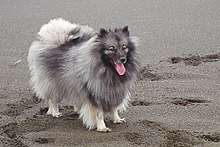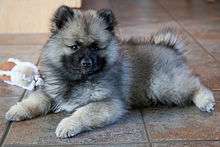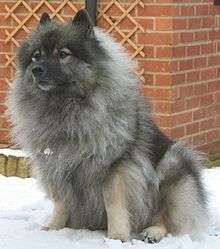Keeshond
The Keeshond (/ˈkeɪshɒnd/ KAYSS-hond, plur. Keeshonden) is a medium-sized dog with a plush, two-layer coat of silver and black fur with a ruff and a curled tail. It originated in Holland, and its closest relatives are the German spitzes such as the Großspitz (Large Spitz), Mittelspitz (Medium Spitz), Kleinspitz (Miniature Spitz), Zwergspitz (Dwarf-Spitz) or Pomeranian.
| Keeshond | |||||||||||||||||||||||||||
|---|---|---|---|---|---|---|---|---|---|---|---|---|---|---|---|---|---|---|---|---|---|---|---|---|---|---|---|
 Distinct characteristics of Keeshonden include a lion-like ruff, spectacles, small and dark triangular ears, definite contrast, and a thick double coat. | |||||||||||||||||||||||||||
| Other names | Dutch Barge Dog, Smiling Dutchman, German Spitz, Deutscher Wolfspitz, Wolfspitz | ||||||||||||||||||||||||||
| Common nicknames | Kees | ||||||||||||||||||||||||||
| Origin | Germany[1] Netherlands | ||||||||||||||||||||||||||
| |||||||||||||||||||||||||||
| |||||||||||||||||||||||||||
| Dog (domestic dog) | |||||||||||||||||||||||||||
The Keeshond was previously known as the Dutch Barge Dog, as it was frequently seen on barges traveling the canals and rivers of The Netherlands. The Keeshond was the symbol of the Patriot faction in The Netherlands during political unrest in the years immediately preceding the French Revolution.
In the late 19th century, the breed was developed in England from imports obtained in both The Netherlands and Germany. In 1930, the Keeshond was first registered with The American Kennel Club.[2]
Description
Appearance
A member of the spitz group of dogs, the Keeshond in American Kennel Club (AKC) standard is 17 inches (43 cm) to 18 inches (46 cm) tall and 19.25 inches (48.9 cm) ± 2.4 inches (6.1 cm) in the Fédération Cynologique Internationale (FCI) standard and weighs 30 pounds (14 kg) to 40 pounds (18 kg). Sturdily built, they have a typical spitz appearance. Neither coarse nor refined, they have a wedge-shaped head, medium-length muzzle with a definite stop, small pointed ears, and an expressive face. The tail is tightly curled and, in profile, should be carried such that it is indistinguishable from the compact body of the dog.
Coat

Like all spitz-type dogs, the Keeshond has a dense double coat, with a thick ruff around the neck. Typically, the males of this breed will have a thicker, more pronounced ruff than the females. The body should be abundantly covered with long, straight, harsh hair standing well out from a thick, downy undercoat. The hair on the legs should be smooth and short, except for a feathering on the front legs and "trousers" on the hind legs. The hair on the tail should be profuse, forming a rich plume. The head, including muzzle, skull, and ears, should be covered with smooth, soft, short hair—velvety in texture on the ears. The coat must not part down the back.
Coat care requires line brushing on a fairly regular basis. The Keeshond typically 'blows' its undercoat once a year for males, twice a year for females. During this time, the loss of coat is excessive and their guard hairs will lie flat to their back. It usually takes 2 weeks for the 'blow' to complete, in order for new undercoat to begin growing back in. A Keeshond should never be shaved, as their undercoat provides a natural barrier against heat and cold. Keeping their coat in good condition will allow efficient insulation in both hot and cold weather.
Color
The color should be a mixture of grey and black and some white as well. The undercoat should be very pale grey or cream (not tawny). The hair of the outer coat is black tipped, the length of the black tips producing the characteristic shading of color. The color may vary from light to dark, but any pronounced deviation from the grey color is not permissible. The plume of the tail should be very light grey when curled on back and the tip of the tail should be black. Legs and feet should be cream. Ears should be very dark - almost black.
Shoulder line markings (light grey) should be well defined. The color of the ruff and "trousers" is generally lighter than that of the body. "Spectacles" and shadings, as later described, are characteristic of the breed and must be present to some degree. There should be no pronounced white markings.
According to the American Kennel Club breed standard, the legs and feet are to be cream; feet that are totally black or white are severe faults. Black markings more than halfway down the foreleg, except for pencilling, are faulted.[3]
The other important marking is the "spectacles," a delicate dark line running from the outer corner of each eye toward the lower corner of each ear, which, coupled with markings forming short eyebrows, is necessary for the distinct expressive look of the breed. All markings should be clear, not muddled or broken. Absence of the spectacles is considered a serious fault. The eyes should be dark brown, almond-shaped with black eye rims.[4]
Ears should be small, dark, triangular, and erect.
Temperament

Keeshonden tend to be very playful, with quick reflexes and strong jumping ability. They are thoughtful, eager to please and very quick learners, which means they are also quick to learn things their humans did not intend to teach them. However, Keeshonden make excellent agility and obedience dogs. In fact, so amenable to proper training is this bright, sturdy dog that they have been successfully trained to serve as guide dogs for the blind; only their lack of size has prevented them from being more widely used in this role.
They love children and are excellent family dogs, preferring to be close to their humans whenever possible. They generally get along with other dogs as well and will enjoy a good chase around the yard. Keeshonden are very intuitive and empathetic and are often used as comfort dogs. Most notably, at least one Keeshond, Tikva, was at Ground Zero following the September 11 attacks to help comfort the rescue workers.[5] The breed has a tendency to become especially clingy towards their owners, more so than most other breeds. If their owner is out, or in another room behind a closed door, they may sit, waiting for their owner to reappear, even if there are other people nearby. Many have been referred to as their "owner's shadow," or "velcro dogs".[6]
They are known by their loud, distinctive bark. Throughout the centuries, the Keeshond has been very popular as a watch dog on barges on canals in the Netherlands and middle Europe. This trait is evident to this day, and they are alert dogs that warn their owners of any new visitors. Although loud and alert, Keeshonden are not aggressive towards visitors. They generally welcome visitors affectionately once their family has accepted them. Unfortunately, barking may become a problem if not properly handled. Keeshonden that are kept in a yard, and not allowed to be with their humans, are unhappy and often become nuisance barkers.
Training
The Keeshond is very bright in work and obedience. The Keeshond ranks 16th in Stanley Coren's The Intelligence of Dogs, being of excellent working/obedience intelligence. This intelligence makes a Keeshond a good choice for the dog owner who is willing to help a dog learn the right lessons, but also entails added responsibility.
While affectionate, Keeshonden are not easy for the inexperienced trainer. Consistency and fairness are needed; and, while most dogs need a structured environment, it is especially necessary with a Keeshond. Like most of the independent-minded spitz breeds, Keeshonden respond poorly to heavy-handed or forceful training methods.
Many behavioral problems with Keeshonden stem from these intelligent dogs inventing their own activities (often destructive ones, like digging and chewing) out of boredom. They need daily contact with their owners and much activity to remain happy. Keeshonden do not live happily alone in a kennel or backyard.
Keeshonden can also be timid dogs. It is important to train them to respect, but not fear, their owners and family. Keeshonden want to please, so harsh punishment is not necessary when the dog does not obey as quickly as desired. They like to spend time with their owners and love attention.
Health

Keeshonden are generally a very healthy breed. Though congenital health issues are not common, the conditions which have been known to sometimes occur in Keeshonden are hip dysplasia, luxating patellas (trick knee), epilepsy, Cushing's disease, diabetes, primary hyperparathyroidism, and hypothyroidism. Von Willebrand's disease has been known in Keeshonden but is very rare. An accurate test for the gene causing primary hyperparathyroidism (or PHPT) has recently been developed at Cornell University. As with any breed, it is important when buying a puppy to make sure that both parents have been tested and certified free from inherited problems. Test results may be obtained from the breeder, and directly from the Orthopaedic Foundation For Animals site.
Keeshonds in a UK Kennel Club survey had a median lifespan of 12 years 2 months. 1 in 4 died of old age, at an average of 14–15 years.[7]
Grooming
Because of their double coat, Keeshonden need regular brushing; an hour a week will keep the dog comfortable and handsome. The Keeshond's coat sheds dirt when dry, and the breed is not prone to doggy odor,[8] so frequent bathing is unnecessary and undesirable. The coat acts as insulation and protects the dog from sunburn and insects, so shaving is not desirable, however some owners find it beneficial to clip their dogs' coats in hotter weather. The coat also loses its distinct color as the black tipping on the hairs will be shorn off. If frequent brushing is too much effort, it is better to choose another breed rather than clip the Keeshond short.
History

The Keeshond was named after the 18th-century Dutch Patriot, Cornelis (Kees) de Gyselaer (spelled 'Gijzelaar' in Modern Dutch), leader of the rebellion against the House of Orange. The dog became the rebels' symbol; and, when the House of Orange returned to power, this breed almost disappeared. The word 'keeshond' is a compound word: 'Kees' is a nickname for Cornelius (de Gyselaer), and 'hond' is the Dutch word for dog. In the Netherlands, "keeshond" is the term for German Spitzes that encompass them all from the toy or dwarf (Pomeranian) to the Wolfspitz (Keeshond). The sole difference among the German Spitzes is their coloring and size guidelines. There are debates over the origin of the breed; many English references point to the Keeshond as we know it originating in the Netherlands. On the other hand, according to the FCI, the breed is cited as being part of the German Spitz family, originating in Germany along with the Pomeranian (toy or dwarf German Spitz) and American Eskimo dog (small or standard German Spitz).[9]
The first standard for "Wolfspitz" was posted at the Dog Show of 1880 in Berlin. The Club for German Spitzes was founded in 1899. The German standard was revised in 1901 to specify the characteristic color that we know today, "silver grey tipped with black". In the late 19th century the "Overweight Pomeranian", a white German Spitz and most likely a Standard German Spitz, was shown in the British Kennel Club. The "Overweight Pomeranian" was no longer recognized by the British Kennel Club in 1915. In the 1920s, Baroness van Hardenbroeck took an interest in the breed and began to build it up again. The Nederlandse Keeshond Club was formed in 1924. The Dutch Barge Dog Club of England was formed in 1925 by Mrs. Wingfield-Digby and accepted into the British Kennel Club in 1926, when the breed and the club were renamed to Keeshond.
Carl Hinderer is credited with bringing his Schloss Adelsburg Kennel, which he founded in 1922 in Germany, with him to America in 1923. His German Champion Wolfspitz followed him two by two in 1926. At that time, less than ten years after World War I, Germany was not regarded fondly in England and America; and the Wolfspitz/Keeshond was not recognized by the AKC. Consequently, Carl had to register each puppy with his club in Germany. Despite this, Carl joined the Maryland KC and attended local shows.
Carl regularly wrote to the AKC, including the New York headquarters, to promote the Wolfspitz. While going through New York on his way to Germany in 1930, Carl visited the AKC offices and presented Wachter, his Germany champion, to AKC President, Dr. DeMond, who promptly agreed to start the recognition process, with some caveats including changing the name to Keeshond, and asked Carl to bring back all the relevant data from Germany. Carl also translated the German standard to English for the AKC. The Keeshond was accepted for AKC registration in 1930.
Despite intense lobbying the FCI would not accept the Keeshond as a separate breed since it viewed the Wolfspitz and Keeshond as identical. In 1997, the German Spitz Club updated its standard so that the typically smaller Keeshond preferred in America and other English-speaking countries could be included. This greatly expanded the gene pool and unified the standard internationally for the first time. Now bred for many generations as a companion dog, the Keeshond easily becomes a loving family member.
As a result of the breed's history and friendly disposition, Keeshonden are sometimes referred to as "The Smiling Dutchman".
Colored Keeshonden
Historically, Keeshonden being part of the German Spitz family had been interbred with their smaller brethren (small, standard, and dwarf German spitzes) and came in several colors—white, black, red, orange, orange-shaded white (also called orange and cream), and silver gray. Originally, like the other German spitzes, many colors, including piebalds, were allowed, but as time progressed, only the silver-grey and cream (wolf-gray) color was finally established into the Wolfspitz type.[10]
No one knows the exact number of colored Keeshonden born in the United States. Incorrect or incomplete documentation makes it impossible to determine how many colored Keeshonden, and of which colors, have been born in the United States.
References
- "GERMAN SPITZ, INCLUDING KEESHOND AND POMERANIAN" (PDF). Fci.be. Retrieved 22 January 2018.
- http://www.ppkf.org/aboutkees.htm
- "Keeshond Breed Standard". American Kennel Club. November 14, 1989. Retrieved April 15, 2011.
- Pavia, Audrey. Guide to Owning a Keeshond. Neptune City, NJ: THF Publications, Inc.
- "Therapy dog back at work grounds: WTC site". Nydailynews.com. Retrieved 22 January 2018.
- "Keeshond". Orvis. The Orvis Company Inc. Retrieved 4 December 2019.
Kees want to be with their people at all times, and are among the 'velcro' breeds who will follow you from room to room of your house.
- "Individual Breed Results for Purebred Dog Health Survey". Thekennelclub.org.uk. Retrieved 22 January 2018.
- "Grooming Your Keeshond | Keeshond Club of America". www.keeshond.org. Retrieved 2019-02-01.
- "Dogs/Breeds/Keeshond". Petwave.com. Retrieved 25 July 2014.
- "Web Hosting, Reseller Hosting & Domain Names from Heart Internet". Dogstuff.info. Archived from the original on 24 February 2005. Retrieved 22 January 2018.
External links
| Wikimedia Commons has media related to Keeshond. |